 -nonsense
-nonsense
British TV production affords Oswald a posthumous trail with actual witnesses
retelling their stories before a serious-minded judge that’s no Judge
Judy. Among witnesses subjected to tense cross-examination (in a Dallas
Federal Courthouse reconstructed in a London studio) are Ruth Paine, Buell
Fraser, Charles Brehm, Bill Newman, Harold Norman, Baker, Callaway, Brewer,
Tillson,
Wecht and O’Connor—plus
HSCA members Kirk, Petty, Lutz and Guinn. Gerry Spence’s anecdotal
“defense” no match for prosecutor Vincent Bugliosi (who’s
reportedly now working on a major study of the assassination). First shown
in US on Showtime on Nov. 21, 1986. No video release or transcript; airing
lengths vary. (Not to be confused with 1977 TV-docudrama
The
Trial of Lee Harvey Oswald.)
 mpressive
mpressive
multi-part effort by British documentary-maker Nigel Turner, ultimately
flawed by Corsican assassination-squad theory. Prominent witnesses finally
interviewed on-location, some recreating their actions.
Groden
and
Wecht shamelessly harp on about
governmental treason. Gary Mack is prominently featured, introducing “Badge
Man,” Gordon Arnold, Beverly Oliver and Ed Hoffman.Then as now, Mack
refuses to abandon the acoustics evidence (see
detailed
evaluation at Reitzes’ site). Still shown occasionally on A&E’s
History Channel, it was released as a condensed version in a video-tape
gift box. Companion volume updating issues called
The Truth Shall Make
You Free (shown). A & E Home
Video
/
DVD.
 omber
omber
documentary applies new scientific techniques to major trajectory and medical
issues.
Thompson,
Wecht,
Baden,
Blakey
and
Lifton featured. Contains Steve
Barber’s discovery on
Gallery’s
paper record of Decker’s cross-talk, computer-model of Single-Bullet
Theory, and visit by Parkland physicians to see autopsy photographs in National
Archives. Has the clearest, most-graphic screening of the Zapruder film
ever presented prior to 1998’s
Image
of an Assassination—a 35mm “technician copy” on loan
from Moses Weitzman, who duped it from the original Zapruder film when
Life
sent it to his New York film lab in 1967. Narrated by Walter Cronkite. Somewhat
dated; computer analysis and animation techniques have since improved. No
video release.



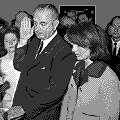






 JFK Assassination: As It Happened
JFK Assassination: As It Happened

A&E, November 22, 1988.
Rebroadcast of original
unedited NBC coverage from first cut-in reports to LBJ speech at Washington
airport. Fascinating five hours of the real thing “as it happened.”
Edited transcript in 1966
There Was a
President. No video release.

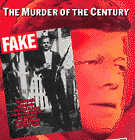

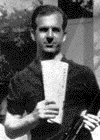



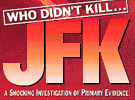



 Who Didn
Who Didn’
t Kill …
JFK

Third Coast Productions, 1990.
 exas
exas
researchers Jack White and
Jim Marrs
“star” in this pre-
JFK video hosted
by Craig Maurer, who sits at a newsdesk introducing various “segments.”
Basically a vehicle to present White’s findings after years of research
into the infamous Oswald Backyard Photos. White’s dedication and persistence
is evident throughout—and the main reason he’s almost-singlehandedly
kept this issue alive since the mid-60s. Very impressive effort, though
strictly for the serious researcher who’s willing to make an effort
to see pass the poor production values. The video that came with my hair
clippers has more pace and continuity. White recently contributed to the
anthologies
Murder in Dealey
Plaza and
Great Zapruder
Hoax. Fast Forward Marketing
video.

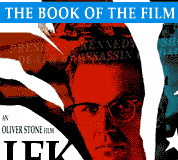














 JFK
JFK

Warner, 1991. Directed by Oliver Stone.
 his
stylish docudrama,
his
stylish docudrama, Hollywood bad-boy Stone plays out his paranoid
fantasies. Haunted by his own Vietnam experience, Stone contends Kennedy
was removed so the Pentagon could goad puppet Lyndon Johnson into escalating
war in Vietnam. Oswald shown
as simple-minded patsy, Jean Hill and Beverly Oliver are star-witnesses
(geeeze!!), and Jim Garrison—played “Mr. Smith”-style by
a bespectacled Kevin Costner—as a crusading hero subverted by CIA/FBI
interference. Based on Garrison’s
On
the Trail of the Assassins and Jim Marrs’
Crossfire.
Movie sparked lots of comment (pro and con), and was generally well-received
by the public and movie critics (see
detailed
evaluation at Reitzes’ site). Credited with inciting public opinion
leading to creation by Congress of JFK Records Review Act. Video version
of “Director’s Cut” includes additional scenes, notably Cosner/Garrison’s
appearance on the
Tonight Show with the Tramp photos.
Robert
Groden served as Technical Advisor and Re-enactment Consultant, accounting
for a major share of the film’s errors. Groden had a brief cameo as
the courtroom projectionist. A 90-minute documentary interviewing actual
witnesses and reviewing real evidence was also released. Called
Beyond
JFK: The Question of Conspiracy, it was included with the
JFK
movie in some packages and was sold on its own (Warner Studios
video).
A book called
JFK: The Book of the Film (Applause Theatre
large-format
softcover, Aug. 1992) was also released. Warner Studios
video
/ “Director’s Cut”
widescreen
video / “Director’s Cut”
DVD.








 Geraldo
Geraldo

“Who Really Killed President Kennedy?”

November 18, 1991.
 his
episode
his
episode began innocently enough, with a live-remote interview
with Marilyn Sitzman, and Marilyn Willis and her daughter Linda on the Grassy
Knoll in Dealey Plaza. Sitzman’s unwavering recollection of the black
couple and their bottle-breaking explains the Black Dog Man shape and dispels
the “puff of smoke” sightings. Of course, none of the critics
watching in the studio associated the mundane events described by Sitzman
with the “better” evidence they had developed of a shot from the
Grassy Knoll. Before the show ended,
Groden
inadvertently confirmed Sitzman’s recollections with a rotoscoped clip
from the Nix film showing the overhanded swinging motion of the bottle-breaking.
No video release.
 Articles
Articles

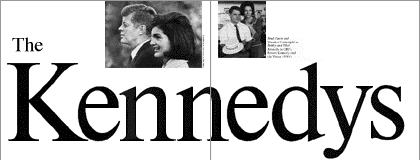








Carson, Tom

The Kennedys
 American Film
American Film / November, 1988
 he
25th anniversary
he
25th anniversary sparked an unusual number of documentaries,
but also one docudrama
The Kennedys of Massachusetts (based on a
book by Doris Kearns Goodwin). For the occasion, Carson offers a four-page
comprehensive review of TV productions celebrating “the only family
that Americans unselfconsciously call a dynasty.” He notes
The Missiles
of October was among the early attempts at docudrama involving modern
history. More elaborate productions followed with the landmark
Kennedy
(1983, Sheen) and heroic
Robert Kennedy and His Times (1995, Brad
Davis). Approving of
Blood Feud but
Hoover vs. The Kennedys
by same producers “a misfire.” Mention of 1977
The
Trial of Lee Harvey Oswald as being more satisfying than sentimentalized
JFK treatments because of fantasy of “tidying up the unresolvable.”
Interestingly, Carson discovered one of “the best TV treatments of
John Kennedy” in
LBJ: The Early Years (1997, Randy Quaid); a
movie that for me set the standard for portraying the Kennedy Era.
(lead-off
spread shown) 
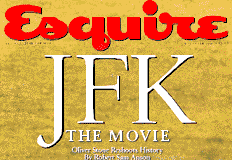



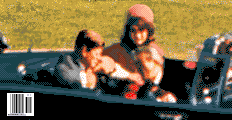





Anson, Robert Sam

The Shooting of JFK
 Esquire
Esquire / November 1991
Remarkable 11-page cover
story on the pre-release controversy of the
JFK
movie, from author of 1975
“They’ve
Killed the President!” Traces how Oliver Stone was drawn to
the Garrison story, despite warnings from some critics. Tells of
John
Newman’s reservations towards
Prouty’s
research. Suggests Stone scuttled
Libra movie project.

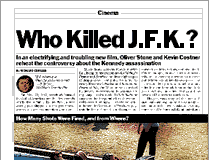





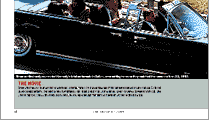




Corliss, Richard

Who Killed J.F.K.?
 Time
Time / December 23, 1991
 ive-page
ive-page
critical review of soon-to-be-released
JFK movie
by Oliver Stone, whose past work suggests the director “screams bloody
murder for a living.” Finds irony in “liberal icon” of
Dances
with Wolves making heroic the disreputable Jim Garrison. As “part
history book, part comic book,” the craft that went into
JFK
resulted in a cinematic “knock-out,” punctuated with “great
visual aids.” Can accept movie as plausible since docudrama may invoke
“gossip that becomes gospel.” Illustrated boxes compare movie
scenes with contradictory evidence, including shots fired, Single-Bullet
Theory, head snap, rigged autopsy and Kennedy’s Vietnam intentions.
Companion three-page interview with
Oliver
Stone, who maintains artists have right to interpret, describes “an
unelected parallel government,” places stock in Oswald’s denial,
and predicts younger generation more receptive to film’s hypothesis.
Personal distrust of authority began through his experience in Vietnam War.
Dissolution of the Soviet Union previous week put Gorbachev on the cover.
(lead-off page shown) 











Auchincloss, Kenneth et al

Twisted History
 Newsweek
Newsweek / December 23, 1991
 OUR-PAGE
OUR-PAGE
cover story examines merits of soon-to-be-released
JFK
movie noting problems with docudrama style (compression of events, clarity
out of messiness) is compounded by basing film on highly-speculative Garrison
theories. Stone’s documentary-style rendering of reconstructions dubious,
and the younger generation, who are Stone’s principal target (ie: film’s
dedication and study guide), are vulnerable having no firsthand experience
with the event. Lists facts omitted from film, including: Oswald owner of
rifle ballistically-tied to bullets that struck the men; autopsy and medical
reviews found all shots hit JFK from the rear; eyewitnesses who identified
Oswald as Tippit murderer; Garrison staff became alarmed at his behavior.
Quotes McGeorge Bundy dismissing 1,000-man withdrawal as shift in Kennedy’s
Vietnam. Box “What Does Oliver Stone Owe History” interviews director
(“parallel covert government has existed through the past 28 years;”
“people like me, sons of Garrison, promulgate the theory”). Companion
article “A Troublemaker for Our Times” on
Stone
is forgiving of his “Mr. Smith Goes to the Assassination” Garrison,
urging it “is perhaps best viewed as a movie convention rather than
as a real man;” also credits Stone with doing justice to the multilayered
complexities of the assassination controversy. Three-page end piece “Bottom
Line: How Crazy is it?” reported some of the conspiracy theories and
researchers encountered at the 1991 JFK Assassination Symposium in Dallas,
detecting reservations about Garrison.







































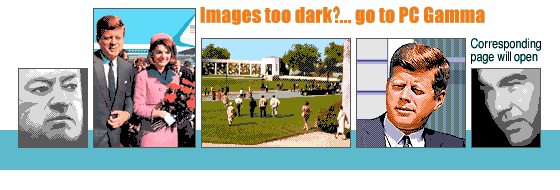 Digital design and contents:
Digital design and contents:
© Copyright 2004 Jerry Organ.
All rights reserved.
Book, magazine, poster and packaging artwork have individual copyright.


Search this site!
